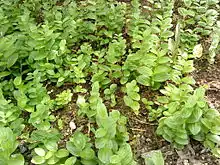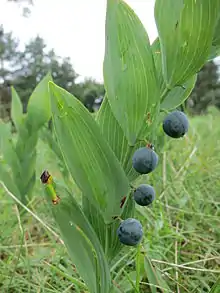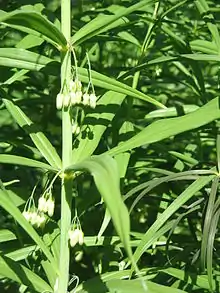Polygonatum
Polygonatum /ˌpɒlɪˈɡɒnətəm/,[2] also known as King Solomon's-seal or Solomon's seal, is a genus of flowering plants. In the APG III classification system, it is placed in the family Asparagaceae, subfamily Nolinoideae (formerly the family Ruscaceae).[3] It has also been classified in the former family Convallariaceae and, like many lilioid monocots, was formerly classified in the lily family, Liliaceae. The genus is distributed throughout the temperate Northern Hemisphere. Most of the approximately 63 species occur in Asia, with 20 endemic to China.[4]
| Polygonatum | |
|---|---|
 | |
| Polygonatum multiflorum | |
| Scientific classification | |
| Kingdom: | Plantae |
| Clade: | Tracheophytes |
| Clade: | Angiosperms |
| Clade: | Monocots |
| Order: | Asparagales |
| Family: | Asparagaceae |
| Subfamily: | Nolinoideae |
| Genus: | Polygonatum Mill. |
| Synonyms[1] | |
| |
Etymology
"Polygonatum" comes from the ancient Greek for "many knees", referring to the multiple jointed rhizome.[5] One explanation for the derivation of the common name "Solomon's seal" is that the roots bear depressions which resemble royal seals. Another is that the cut roots resemble Hebrew characters.[6]
Description
The fruits are red or black berries.
Taxonomy


Species
As of June 2014, the World Checklist of Selected Plant Families accepts 74 species and hybrids:[1]
- Polygonatum acuminatifolium Kom.
- Polygonatum adnatum S.Yun Liang
- Polygonatum altelobatum Hayata
- Polygonatum alternicirrhosum Hand.-Mazz.
- Polygonatum amabile Yatabe
- Polygonatum arisanense Hayata
- Polygonatum × azegamii (Ohwi) M.N.Tamura
- Polygonatum biflorum (Walter) Elliott (including Polygonatum commutatum) – Solomon's seal, Smooth or Great Solomon's seal – Eastern and central North America
- Polygonatum brevistylum Baker
- Polygonatum × buschianum Tzvelev
- Polygonatum cathcartii Baker
- Polygonatum chingshuishanianum S.S.Ying
- Polygonatum cirrhifolium (Wall.) Royle – Tendril-leaf Solomon's seal – Southern China
- Polygonatum cryptanthum H.Lév. & Vaniot
- Polygonatum curvistylum Hua
- Polygonatum cyrtonema Hua – Solomon's seal – Eastern Asia
- Polygonatum × desoulavyi Kom.
- Polygonatum × domonense Satake
- Polygonatum falcatum A.Gray – Eastern Asia
- Polygonatum filipes Merr. ex C.Jeffrey & McEwan
- Polygonatum franchetii Hua
- Polygonatum geminiflorum Decne.
- Polygonatum glaberrimum K.Koch
- Polygonatum gracile P.Y.Li
- Polygonatum graminifolium Hook.
- Polygonatum grandicaule Y.S.Kim
- Polygonatum griffithii Baker
- Polygonatum hirtellum Hand.-Mazz.
- Polygonatum hirtum (including Polygonatum latifolium) (Bosc ex Poir.) Pursh
- Polygonatum hookeri Baker
- Polygonatum humile Fisch. ex Maxim. – Dwarf Solomon's seal – Eastern Asia
- Polygonatum × hybridum Brügger – Garden Solomon's seal – Europe
- Polygonatum inflatum Kom. – Eastern Asia
- Polygonatum infundiflorum Y.S.Kim
- Polygonatum involucratum (Franch. & Sav.) Maxim. – Asia
- Polygonatum jinzhaiense D.C.Zhang & J.Z.Shao
- Polygonatum kingianum Collett & Hemsl. – Solomon's seal – Asia
- Polygonatum × krylovii (Ameljcz. & Malachova) A.L.Ebel
- Polygonatum lasianthum Maxim. – Korean solomon's seal[7] – Eastern Asia
- Polygonatum leiboense S.C.Chen & D.Q.Liu
- Polygonatum longipedunculatum S.Yun Liang
- Polygonatum longistylum Y.Wan ex C.Z.Gao
- Polygonatum macranthum (Maxim.) Koidz.
- Polygonatum macropodum Turcz. – Big Footed Solomon's Seal – Asia
- Polygonatum megaphyllum P.Y.Li
- Polygonatum mengtzense F.T.Wang & Tang
- Polygonatum multiflorum (L.) All. – (Common) Solomon's Seal – Europe
- Polygonatum nervulosum Baker
- Polygonatum nodosum Hua
- Polygonatum odoratum (Mill.) Druce – Scented (or Angular) Solomon's Seal – Europe
- Polygonatum omeiense Z.Y.Zhu
- Polygonatum oppositifolium (Wall.) Royle
- Polygonatum orientale Desf. – Oriental Solomon's Seal – Western Asia, Eastern Europe
- Polygonatum prattii Baker
- Polygonatum × pseudopolyanthemum Miscz. ex Grossh.
- Polygonatum pubescens (Willd.) Pursh – Downy/Hairy Solomon's Seal – Eastern North America
- Polygonatum punctatum Royle ex Kunth
- Polygonatum qinghaiense Z.L.Wu & Y.C.Yang
- Polygonatum robustum (Korsh.) Nakai
- Polygonatum roseum (Ledeb.) Kunth
- Polygonatum sewerzowii Regel
- Polygonatum sibiricum Redouté – Huang Jing, Siberian Solomon's Seal – Eastern Asia
- Polygonatum singalilense H.Hara
- Polygonatum sparsifolium F.T.Wang & Tang
- Polygonatum stenophyllum Maxim.
- Polygonatum stewartianum Diels
- Polygonatum × tamaense H.Hara
- Polygonatum tessellatum F.T.Wang & Tang
- Polygonatum verticillatum (L.) All. – Whorled Solomon's Seal – Europe
- Polygonatum vietnamicum L.I.Abramova
- Polygonatum wardii F.T.Wang & Tang
- Polygonatum yunnanense H.Lév.
- Polygonatum zanlanscianense Pamp.
- Polygonatum zhejiangensis X.J.Xue & H.Yao
Uses
Gardening
Several species are valued as ornamental plants, including:[8]
|
|
|
Food
Many species have long been used as food in China, such as Polygonatum sibiricum. Leaves, stems, and rhizomes are used raw or cooked and served as a side dish with meat and rice. The rhizomes of two local species are eaten with chicken's or pig's feet during festivals. The rhizomes are used to make tea or soaked in wine or liquor to flavor the beverages. They are also fried with sugar and honey to make sweet snacks. The starchy rhizomes can be dried, ground, and added to flour to supplement food staples. The rhizome of P. sibiricum is pulped, boiled, strained, and thickened with barley flour to make a sweet liquid seasoning agent called tangxi. At times, people in China have relied on P. megaphyllum as a famine food.[4]
The shoots of some Polygonatum can be boiled and used like asparagus. P. cirrifolium and P. verticillatum are used as leafy vegetables in India. The American species P. biflorum has a starchy root that was eaten like the potato and used as flour for bread.[4]
Traditional medicine
The traditional use of Polygonatum in the treatment of diabetes was first observed in 1930 by Hedwig Langecker. After experiments, she concluded that it was effective in fighting nutritional hyperglycemia, though not that caused by adrenaline release, probably due to its glucokinin content.[9]
P. verticillatum is used in Ayurveda as an aphrodisiac.[10] It is also used to treat pain, fever, inflammation, allergy, and weakness.[11]
An herbal remedy called rhizoma polygonati is a mix of Polygonatum species used in traditional Chinese medicine. It is supposed to strengthen various organs and enhance the qi.[4] Polygonatum is believed to be restorative to mental vitality, especially when the mind has been overworked, overstressed, or is in a state of exhaustion.[12]
See also
References
- Search for "Polygonatum", World Checklist of Selected Plant Families, Royal Botanic Gardens, Kew, retrieved 2014-06-26
- Sunset Western Garden Book. 1995. 606–607.
- Chase, M. W.; Reveal, J. L. & Fay, M. F. (2009), "A subfamilial classification for the expanded asparagalean families Amaryllidaceae, Asparagaceae and Xanthorrhoeaceae", Botanical Journal of the Linnean Society, 161 (2): 132–136, doi:10.1111/j.1095-8339.2009.00999.x
- Wujisguleng, W., et al. (2012). Ethnobotanical review of food uses of Polygonatum (Convallariaceae) in China. Acta Societatis Botanicorum Poloniae 81(4) 239-44.
- Coombes, A. J. (2012). The A to Z of Plant Names. USA: Timber Press. pp. 312.
- Solomon's Seal. Botanical.com
- English Names for Korean Native Plants (PDF). Pocheon: Korea National Arboretum. 2015. p. 582. ISBN 978-89-97450-98-5. Archived from the original (PDF) on 25 May 2017. Retrieved 24 December 2016 – via Korea Forest Service.
- RHS A-Z Encyclopedia of Garden Plants. United Kingdom: Dorling Kindersley. 2008. p. 1136. ISBN 978-1405332965.
- Source:Quer, Pío Font "Plantas Medicinales - El Dioscórides renovado". 1961/2005 Barcelona: Ediciones Península, ISBN 9788483072424
- Kasmi, I., et al. (2012). Aphrodisiac properties of Polygonatum verticillatum leaf extract. Asian Pacific Journal of Tropical Disease S841-45.
- Khan, H., et al. (2011). Antinociceptive activity of aerial parts of Polygonatum verticillatum: Attenuation of both peripheral and central pain mediators. Phytotherapy Research 25(7) 1024-30.
- Teeguarden, Ron (1 March 2000). The Ancient Wisdom of the Chinese Tonic Herbs (1st ed.). Grand Central Publishing. p. 216. ISBN 978-0446675062.
| Wikimedia Commons has media related to Polygonatum. |
